HONDA RIDGELINE 2020 (in English) Repair Manual
Manufacturer: HONDA, Model Year: 2020, Model line: RIDGELINE, Model: HONDA RIDGELINE 2020Pages: 591, PDF Size: 32.88 MB
Page 61 of 591
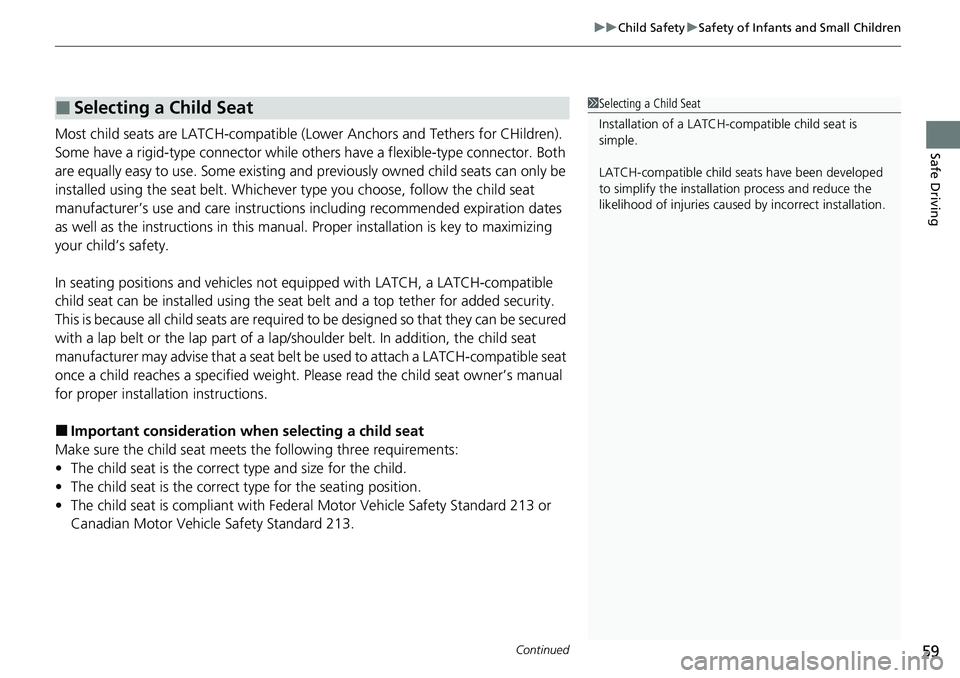
Continued59
uuChild Safety uSafety of Infants and Small Children
Safe DrivingMost child seats are LATCH-compatible (L ower Anchors and Tethers for CHildren).
Some have a rigid-type connector while others have a flexible-type connector. Both
are equally easy to use. Some existing and previously owned child seats can only be
installed using the seat belt. Whichever type you choose, follow the child seat
manufacturer’s use and care instructions including recommended expiration dates
as well as the instructions in this manual . Proper installation is key to maximizing
your child’s safety.
In seating positions and vehicles not equipped with LATCH, a LATCH-compatible
child seat can be installed using the seat belt and a top tether for added security.
This is because all child seats are required to be designed so that they can be secured
with a lap belt or the lap part of a lap/shoulder belt. In addition, the child seat
manufacturer may advise that a seat belt be used to attach a LATCH-compatible seat
once a child reaches a specified weight. Pl ease read the child seat owner’s manual
for proper installation instructions.
■Important consideration when selecting a child seat
Make sure the child seat meets the following thr ee requirements:
• The child seat is the correct type and size for the child.
• The child seat is the correct type for the seating position.
• The child seat is compliant with Federa l Motor Vehicle Safety Standard 213 or
Canadian Motor Vehicle Safety Standard 213.
■Selecting a Child Seat1 Selecting a Child Seat
Installation of a LATCH-co mpatible child seat is
simple.
LATCH-compatible child s eats have been developed
to simplify the installati on process and reduce the
likelihood of injuries caused by incorrect installation.
Page 62 of 591
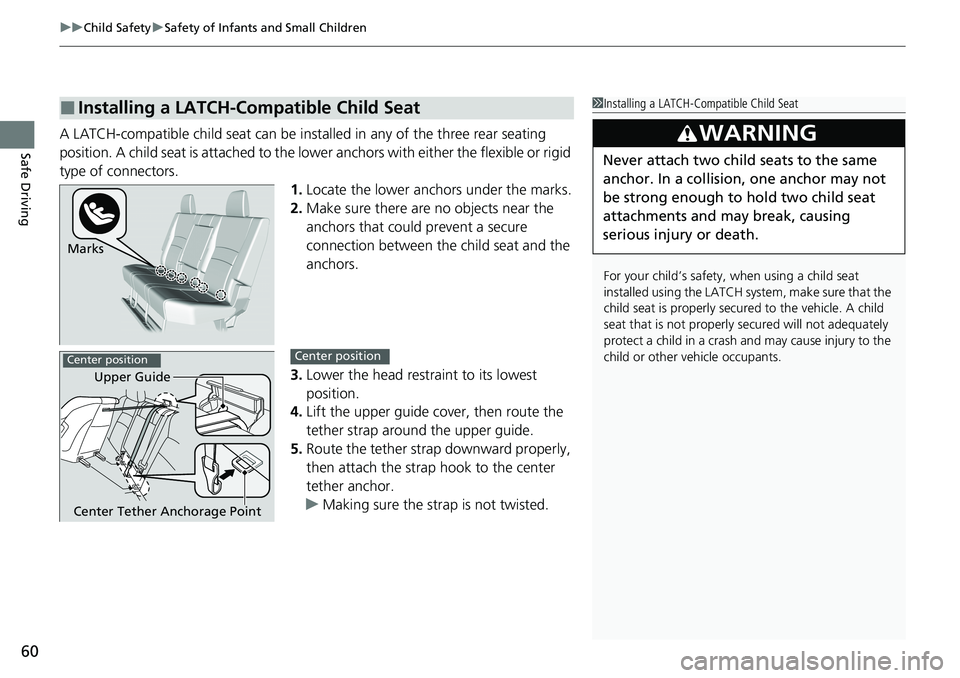
uuChild Safety uSafety of Infants and Small Children
60
Safe DrivingA LATCH-compatible child seat can be inst alled in any of the three rear seating
position. A child seat is attached to the lowe r anchors with either the flexible or rigid
type of connectors. 1.Locate the lower anchors under the marks.
2. Make sure there are no objects near the
anchors that could prevent a secure
connection between the child seat and the
anchors.
3. Lower the head restra int to its lowest
position.
4. Lift the upper guide co ver, then route the
tether strap around the upper guide.
5. Route the tether strap downward properly,
then attach the strap hook to the center
tether anchor.
u Making sure the strap is not twisted.
■Installing a LATCH-Compatible Child Seat1Installing a LATCH-Compatible Child Seat
For your child’s safety, when using a child seat
installed using the LATCH system, make sure that the
child seat is properly secured to the vehicle. A child
seat that is not properly secured will not adequately
protect a child in a crash and may cause injury to the
child or other vehicle occupants.
3WARNING
Never attach two child seats to the same
anchor. In a collision, one anchor may not
be strong enough to hold two child seat
attachments and may break, causing
serious injury or death.
Marks
Upper Guide
Center Tether Anchorage Point
Center positionCenter position
Page 63 of 591

61
uuChild Safety uSafety of Infants and Small Children
Continued
Safe Driving
6. Place the child seat on the vehicle seat, then
attach the child seat to the lower anchors
according to the ins tructions that came
with the child seat.
Flexible Type
Lower Anchors
All positions
Rigid Type
Page 64 of 591

62
uuChild Safety uSafety of Infants and Small Children
Safe Driving
7. Put the outer head restraint to it’s upper-
most position (or remove it), then route
the tether strap over the seat-back and
through the head restraint legs.
8. Lift the upper guide co ver, then route the
tether strap around the upper guide.
9. Route the tether strap downward
properly, then attach the strap hook to the
tether anchor under the seat. See the
label.
u Making sure the strap is not twisted.
10. Tighten the tether strap as instructed by
the child seat manufacturer.
11. Make sure the child seat is firmly secured
by rocking it forward and back and side to
side; little movement should be felt.
12. Make sure any unused seat belt that a
child can reach is buckled, the lockable
retractor is activated, and the belt is fully
retracted and locked.
2Protecting Child Passengers P. 55
Upper Guide
Outer Tether Anchorage PointsOuter positionsOuter positions
Upper Guide
Outer Tether Anchorage PointsOuter positionsAll positions
Page 65 of 591

Continued63
uuChild Safety uSafety of Infants and Small Children
Safe DrivingA child seat can be installed with a lap/shoulder belt in any rear seat or, if absolutely
necessary, the front passenger seat.
1.Place the child seat on the vehicle seat.
2. Route the seat belt through the child seat
according to the seat manufacturer’s
instructions, and insert the latch plate into
the buckle.
u Insert the latch plate fully until it clicks.
3. Slowly pull the shoulder part of the belt all
the way out until it stops. This activates the
lockable retractor.
4. Let the seat belt retract a few inches and
check that the retractor has switched
modes by pulling on the webbing. It should
not pull out again until it is reset by
removing the latch pl ate from the buckle.
u If you are able to pull the shoulder belt
out, the lockable retractor is not
activated. Slowly pull the seat belt all the
way out, and repeat steps 3 – 4.
■Installing a Child Seat with a Lap/Shoulder Seat Belt1 Installing a Child Seat with a Lap/Shoulder Seat Belt
A child seat that is not properly secured will not
adequately protect a child in a crash and may cause
injury to the child or other vehicle occupants.
Page 66 of 591
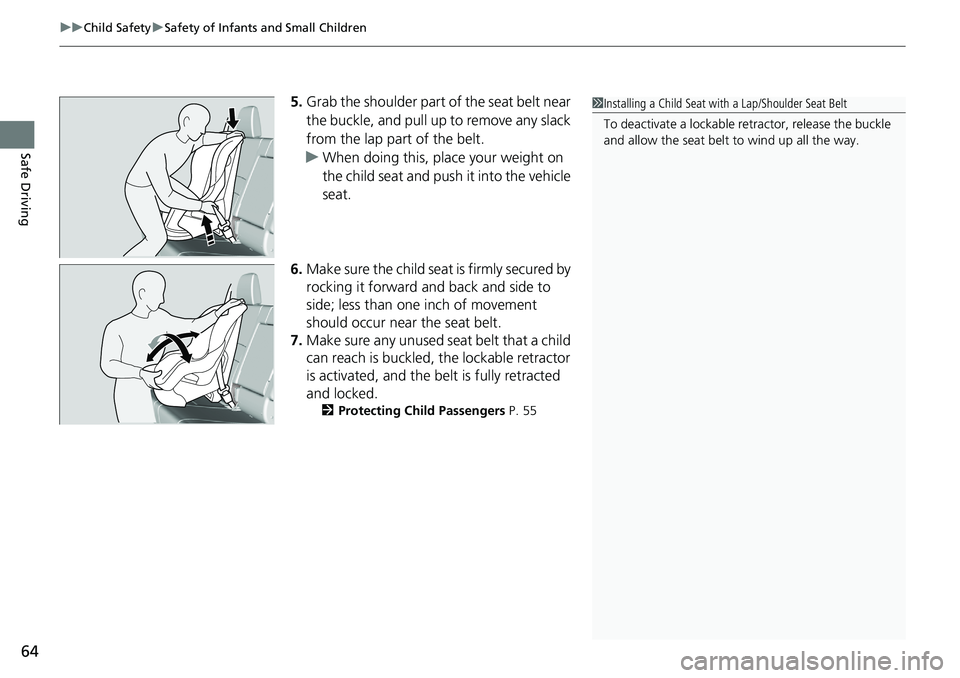
uuChild Safety uSafety of Infants and Small Children
64
Safe Driving
5. Grab the shoulder part of the seat belt near
the buckle, and pull up to remove any slack
from the lap part of the belt.
u When doing this, place your weight on
the child seat and push it into the vehicle
seat.
6. Make sure the child seat is firmly secured by
rocking it forward and back and side to
side; less than one inch of movement
should occur near the seat belt.
7. Make sure any unused se at belt that a child
can reach is buckled, the lockable retractor
is activated, and the be lt is fully retracted
and locked.
2 Protecting Child Passengers P. 55
1Installing a Child Seat with a Lap/Shoulder Seat Belt
To deactivate a lockable retractor, release the buckle
and allow the seat belt to wind up all the way.
Page 67 of 591
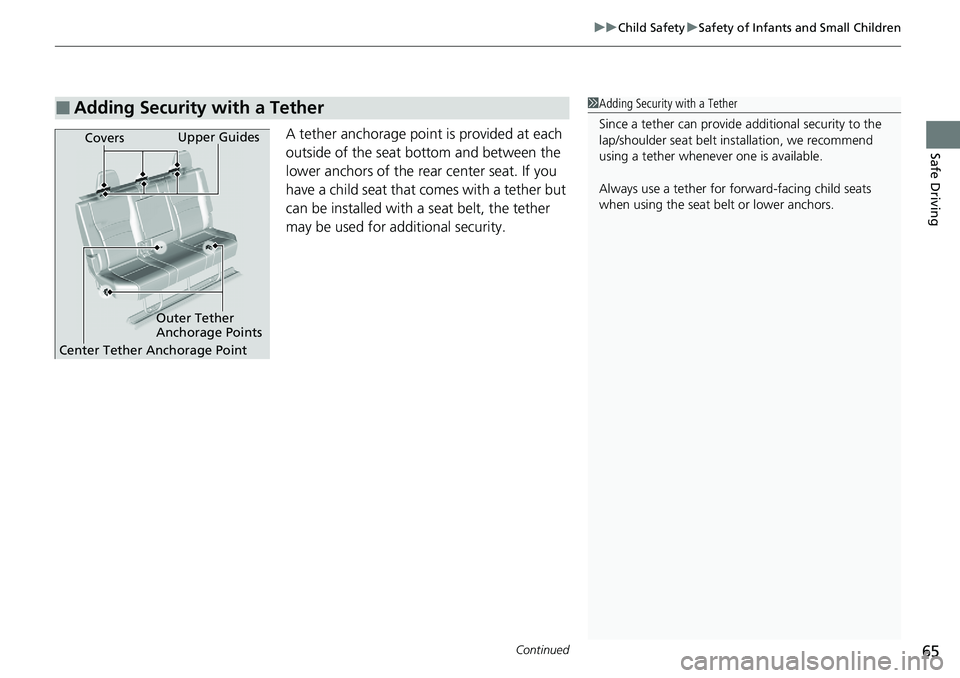
Continued65
uuChild Safety uSafety of Infants and Small Children
Safe DrivingA tether anchorage poin t is provided at each
outside of the seat bottom and between the
lower anchors of the rear center seat. If you
have a child seat that comes with a tether but
can be installed with a seat belt, the tether
may be used for additional security.
■Adding Security with a Tether
Covers
Outer Tether
Anchorage PointsUpper Guides
Center Tether Anchorage Point
1 Adding Security with a Tether
Since a tether can provide additional security to the
lap/shoulder seat belt in stallation, we recommend
using a tether whenever one is available.
Always use a tether for forward-facing child seats
when using the seat be lt or lower anchors.
Page 68 of 591
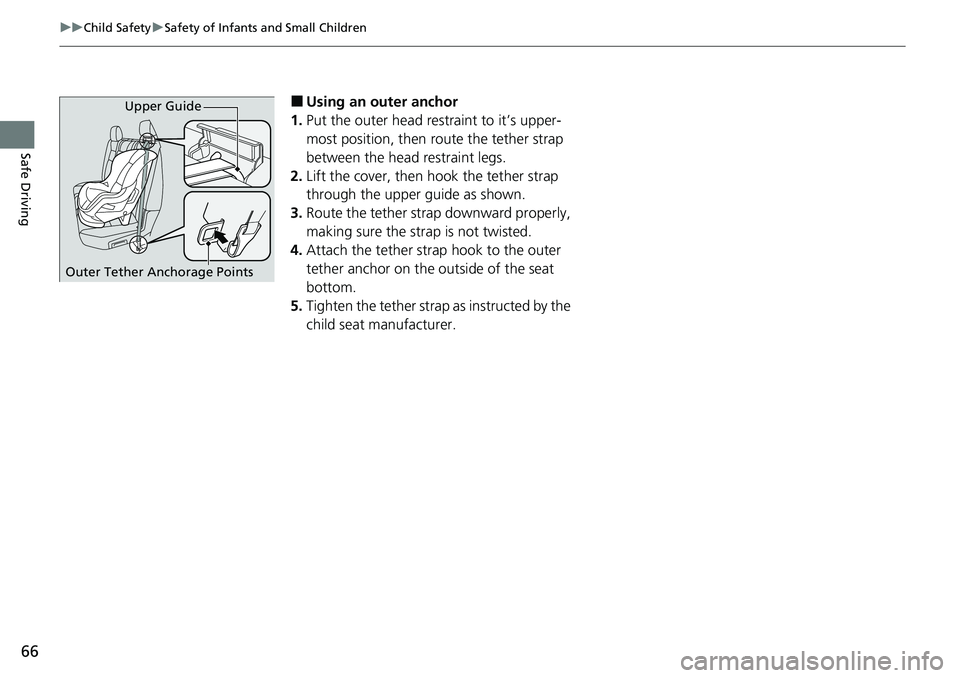
66
uuChild Safety uSafety of Infants and Small Children
Safe Driving
■Using an outer anchor
1. Put the outer head restraint to it’s upper-
most position, then route the tether strap
between the head restraint legs.
2. Lift the cover, then hook the tether strap
through the upper guide as shown.
3. Route the tether strap downward properly,
making sure the strap is not twisted.
4. Attach the tether strap hook to the outer
tether anchor on the outside of the seat
bottom.
5. Tighten the tether strap as instructed by the
child seat manufacturer.
Outer Tether Anchorage Points Upper Guide
Page 69 of 591
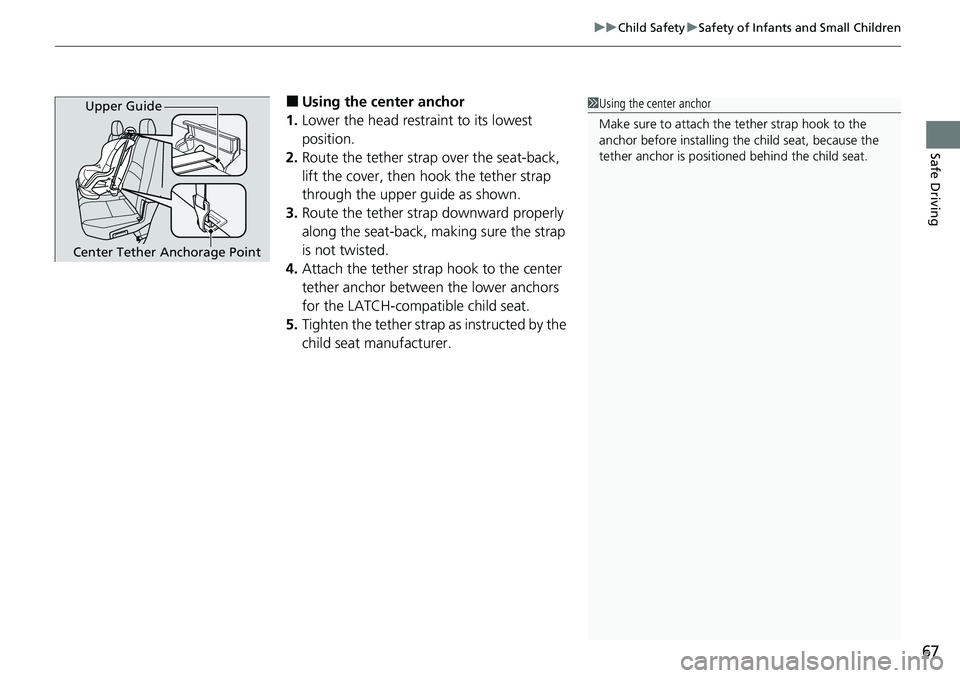
67
uuChild Safety uSafety of Infants and Small Children
Safe Driving
■Using the center anchor
1. Lower the head restraint to its lowest
position.
2. Route the tether strap over the seat-back,
lift the cover, then hook the tether strap
through the upper guide as shown.
3. Route the tether strap downward properly
along the seat-back, making sure the strap
is not twisted.
4. Attach the tether strap hook to the center
tether anchor between the lower anchors
for the LATCH-compatible child seat.
5. Tighten the tether strap as instructed by the
child seat manufacturer.1Using the center anchor
Make sure to attach the tether strap hook to the
anchor before installing th e child seat, because the
tether anchor is positione d behind the child seat.Upper Guide
Center Tether Anchorage Point
Page 70 of 591
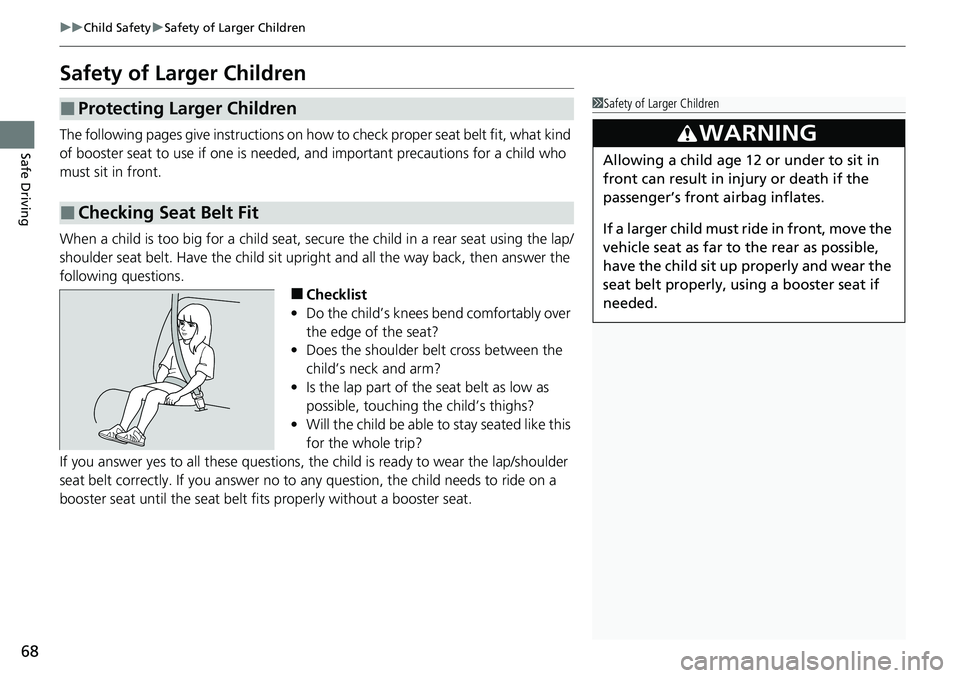
68
uuChild Safety uSafety of Larger Children
Safe Driving
Safety of Larger Children
The following pages give instructions on how to check proper seat belt fit, what kind
of booster seat to use if one is needed , and important precautions for a child who
must sit in front.
When a child is too big for a child seat, secure the child in a rear seat using the lap/
shoulder seat belt. Have the child sit upright and all the way back, then answer the
following questions.
■Checklist
• Do the child’s knees bend comfortably over
the edge of the seat?
• Does the shoulder belt cross between the
child’s neck and arm?
• Is the lap part of the seat belt as low as
possible, touching the child’s thighs?
• Will the child be able to stay seated like this
for the whole trip?
If you answer yes to all these questions, the child is ready to wear the lap/shoulder
seat belt correctly. If you answer no to any question, the child needs to ride on a
booster seat until the seat belt fits properly without a booster seat.
■Protecting Larger Children
■Checking Seat Belt Fit
1 Safety of Larger Children
3WARNING
Allowing a child age 12 or under to sit in
front can result in injury or death if the
passenger’s front airbag inflates.
If a larger child must ride in front, move the
vehicle seat as far to the rear as possible,
have the child sit up properly and wear the
seat belt properly, us ing a booster seat if
needed.